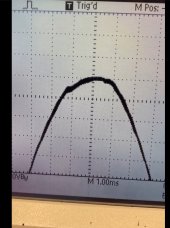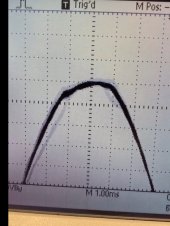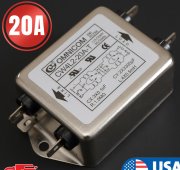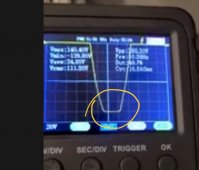Jazzmonger
Hacker at heart
I had exactly the same thing happen with my LV6048 inverter. All of my LED shop lights flickered periodically, and for no apparent reason. Then I installed 2 LV6548s and the problem went away. I isolated and captured the problem on an oscilloscope trace - it's periodic noise on the output of the inverter sine wave that is the culprit.
normal trace of 120v inverter output, no flicker:

Periodic noise (no cause that I could find) induced by the inverter at periodic intervals:

THIS is what causes the flicker. Get rid of the noise on the 120v line and the flicker will go away as well.
As a kid I was the renowned Bay Area expert in eliminating engine noise in massive car stereo systems in the 1980's. Looking at the traces on my scope, this is literally no different. It's line noise. Before getting the LV6548s I ordered a 20amp line filter that should eliminate this problem. They make a 50amp version as well but I was going to try it first on the light circuit just to be sure it solved the problem, then filter the entire 50a output. Note this would require 2 50a filters, one for each 120v leg. Or just use the 20a filter on the light circuits.
this is what I ordered:
line filter

Now, I have it, but never tested it bc I ended up installing the LV6548s for my shop and house and they don't suffer from this issue, but based on the scope traces it should fix the flickering problem. For $16, it certainly might be worth a try?
anyone else tried this???
Jeff
.
normal trace of 120v inverter output, no flicker:

Periodic noise (no cause that I could find) induced by the inverter at periodic intervals:

THIS is what causes the flicker. Get rid of the noise on the 120v line and the flicker will go away as well.
As a kid I was the renowned Bay Area expert in eliminating engine noise in massive car stereo systems in the 1980's. Looking at the traces on my scope, this is literally no different. It's line noise. Before getting the LV6548s I ordered a 20amp line filter that should eliminate this problem. They make a 50amp version as well but I was going to try it first on the light circuit just to be sure it solved the problem, then filter the entire 50a output. Note this would require 2 50a filters, one for each 120v leg. Or just use the 20a filter on the light circuits.
this is what I ordered:
line filter

Now, I have it, but never tested it bc I ended up installing the LV6548s for my shop and house and they don't suffer from this issue, but based on the scope traces it should fix the flickering problem. For $16, it certainly might be worth a try?
anyone else tried this???
Jeff
.
Last edited:



